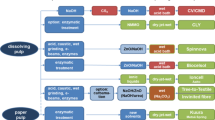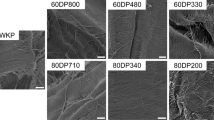Abstract
The study investigated the impact of fiber initial water content (FIWC) on the poplar APMP fibers’ water retention capacity. In this work, FIWC refers to the water content of samples before drying, obtained by the different centrifugation forces at the given conditions. The results showed that the water retention value of pulps increased with the decrease in FIWC when it was below 60%, with or without thermal drying. An analysis of the fibers showed a slight decrease in the average pore size took place with the decrease in FIWC for the never-dried pulps. Based on these findings, a mechanism of the impact of FIWC on the poplar APMP water retention capacity was proposed. The present work will be helpful for a better understanding of the thermal drying-induced hornification.





Similar content being viewed by others
References
Bardet R, Reverdy C, Belgacem N, Leirset I, Syverud K, Bardet M, Bras J (2015) Substitution of nanoclay in high gas barrier films of cellulose nanofibrils with cellulose nanocrystals and thermal treatment. Cellulose 22(2):1227–1241. https://doi.org/10.1007/s10570-015-0547-9
Bian H, Chen L, Dai H, Zhu JY (2017) Effect of fiber drying on properties of lignin containing cellulose nanocrystals and nanofibrils produced through maleic acid hydrolysis. Cellulose 24(10):4205–4216. https://doi.org/10.1007/s10570-017-1430-7
Brancato A, Banerjee S (2010) Effect of recycling on the surface and pore structure of wood fibre. Appita J J Tech Assoc Aust N Z Pulp Pap Ind 63(1):42
Chen Y, Wang Y, Wan J, Ma Y (2010) Crystal and pore structure of wheat straw cellulose fiber during recycling. Cellulose 17(2):329–338. https://doi.org/10.1007/s10570-009-9368-z
Chen Y, Wan J, Huang M, Ma Y, Wang Y, Lv H, Yang J (2011) Influence of drying temperature and duration on fiber properties of unbleached wheat straw pulp. Carbohyd Polym 85(4):759–764. https://doi.org/10.1016/j.carbpol.2011.03.041
Diniz JF, Gil MH, Castro J (2004) Hornification—its origin and interpretation in wood pulps. Wood Sci Technol 37(6):489–494
Esteghlalian AR, Bilodeau M, Mansfield SD, Saddler JN (2001) Do enzymatic hydrolyzability and Simons’ stain reflect the changes in the accessibility of lignocellulosic substrates to cellulase enzymes? Biotechnol Progr 17(6):1049–1054. https://doi.org/10.1021/bp0101177
Graham AG, Ko YC (1995) The microporosity of pulp. The forces influencing the intra and inter-fiber pore structure and pore size distribution in pulp and paper. Cell Chem Technol 29(4):479–485
Hubbe MA, Venditti RA, Barbour RL, Zhang M (2003) Changes to unbleached kraft fibers due to drying and recycling. Prog Pap Recycl 12(3):11–20
Hubbe MA, Venditti RA, Rojas OJ (2007) What happens to cellulosic fibers during papermaking and recycling? A review. BioResources 2(4):739–788
ISO 23714 (2007) Pulps-determination of water retention value (WRV). ISO International Standard, Geneva
Jayme G (1944) Micro-swelling measurement in cellulosic pulp. Papier-fabr Wochenbl Papierfabr 6:187–194
Jayme G, Hunger G (1957) The rearrangement of microfibrils in dried cellulose and the implication of this structure alteration on pulp properties. In: Bolam F (ed) Fundamentals of papermaking fibres. BPBMA, Cambridge, pp 263–270
Kekäläinen K, Liimatainen H, Illikainen M, Maloney TC, Niinimäki J (2014) The role of hornification in the disintegration behaviour of TEMPO-oxidized bleached hardwood fibres in a high-shear homogenizer. Cellulose 21(3):1163–1174. https://doi.org/10.1007/s10570-014-0210-x
Laivins GV, Scallan AM (1993) The mechanism of hornification of wood pulps. Prod Papermak 2:1235
Li Y, Li B, Mo W, Yang W, Wu S (2019) Influence of residual lignin and thermal drying on the ultrastructure of chemical hardwood pulp and its enzymatic hydrolysis properties. Cellulose 26(3):2075–2085. https://doi.org/10.1007/s10570-018-2184-6
Lindström T (1986) The porous lamellar structure of the cell wall. In: Bristow J, Kolseth P (eds) Paper, structure and properties. Marcel Dekker, New York, pp 99–109
Mo W, Li B, Li Y, Li Y, Wu S (2019) Overcoming the drying-induced pore closure of APMP poplar fibers in old newsprint by surfactant treatment to promote enzymatic hydrolysis of the cellulose. Cellulose 26(9):5529–5541. https://doi.org/10.1007/s10570-019-02471-4
Nazhad MM, Ramos LP, Paszner L, Saddler JN (1995) Structural constraints affecting the initial enzymatic hydrolysis of recycled paper. Enzyme Microb Technol 17(1):68–74. https://doi.org/10.1016/0141-0229(94)00057-x
Newman RH (2004) Carbon-13 NMR evidence for cocrystallization of cellulose as a mechanism for hornification of bleached kraft pulp. Cellulose 11(1):45–52. https://doi.org/10.1023/b:cell.0000014768.28924.0c
Newman R, Hemmingson J (1997) Cellulose cocrystallization in hornification of kraft pulp. In: 9th international symposium on wood and pul** chemistry. Montreal, Canada, pp 1–4
Pönni R, Vuorinen T, Kontturi E (2012) Proposed nano-scale coalescence of cellulose in chemical pulp fibers during technical treatments. BioResources 7(4):6077–6108. https://doi.org/10.15376/biores.7.4.6077-6108
Pönni R, Rautkari L, Hill CAS, Vuorinen T (2014) Accessibility of hydroxyl groups in birch kraft pulps quantified by deuterium exchange in D2O vapor. Cellulose 21(3):1217–1226. https://doi.org/10.1007/s10570-014-0166-x
Ruffini G (1966) Improvement of bonding in wood pulps by presence of acidic groups. Svensk Papperstidn 69(3):72
Scallan AM (1974) The structure of the cell wall of wood—a consequence of anisotropic inter-microfibrillar bonding? Wood Sci For Prod Res Soc 3:531–545
Sluiter A, Hames B, Ruiz RO, Scarlata C, Sluiter J, Templeton D (2008) Determination of structural carbohydrates and lignin in biomass. National Renewable Energy Laboratory, Golden
Stone JE, Scallan AM (1968) Structural model for the cell wall of water-swollen wood pulp fibers based on their accessibility to macromolecules. Cellul Chem Technol 2(3):343–358
Thybring EE, Thygesen LG, Burgert I (2017) Hydroxyl accessibility in wood cell walls as affected by drying and re-wetting procedures. Cellulose 24(6):2375–2384. https://doi.org/10.1007/s10570-017-1278-x
Wang R, Mo W, Shen X, Li B, Chai X (2019) The correlation between the water retention values of fibers by the centrifugation method and maximum content of fiber bonding water by the headspace GC method. Nord Pulp Pap Res J 34(3):304–309
Weise U (1998) Hornification: mechanisms and terminology. Pap Puu 80(2):110–115
Weise U, Paulapuro H (1999) Effect of drying and rewetting cycles on fibre swelling. J Pulp Pap Sci 25(5):163–166
Welf ES, Venditti RA, Hubbe MA, Pawlak JJ (2005) The effects of heating without water removal and drying on the swelling as measured by water retention value and degradation as measured by intrinsic viscosity of cellulose papermaking fibers. Prog Pap Recycl 14(3):5–13
Acknowledgements
This work was funded by the National Natural Science Foundation of China (31470607), the open-funds (201320) of State Key Laboratory of Pulp and Paper Engineering of SCUT (South China University of Technology), China, Natural Science Foundation of Guangdong Province (2015A0303) and Guangzhou Science and Technology Planning Project (201607020025).
Author information
Authors and Affiliations
Corresponding author
Ethics declarations
Conflict of interest
The authors declare that they have no conflict of interest.
Additional information
Publisher's Note
Springer Nature remains neutral with regard to jurisdictional claims in published maps and institutional affiliations.
Rights and permissions
About this article
Cite this article
Mo, W., Li, B. & Chai, XS. Impact of fiber initial water content on the water retention capacity of poplar APMP fibers during the thermal drying. Wood Sci Technol 54, 227–235 (2020). https://doi.org/10.1007/s00226-019-01148-2
Received:
Published:
Issue Date:
DOI: https://doi.org/10.1007/s00226-019-01148-2




